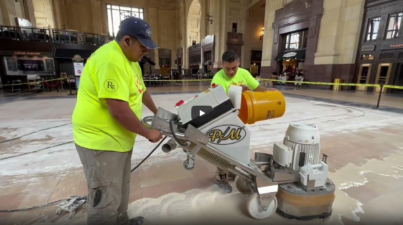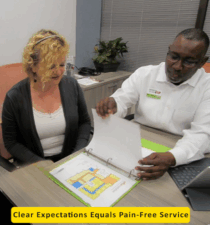Snow often brings ice, and if predictions are correct, we’ll get more snow in 2019 than we’ve gotten in a while. Kansas City gets, on average, between 18 and 19 inches of snow each year. In the last three years, we’ve gotten less than 10 inches of snow each year. According to Gary Lezak, KSHB-41’s weatherman, we’ll get above-average amounts of snow this year. It appears he’s right. In our first major snow storm of 2019, which was on January 12th—the same day the Chiefs routed the Colts in the playoffs—some parts of Kansas City got more than 8 inches of snow!

As a building owner, facility director, or property manager, you have to keep your building’s sidewalks and parking lots ice-free, and to do so, you need plenty of ice melt. Ice melt is great because it keeps us from slipping on sidewalks and streets, but it’s only great outdoors. When it gets inside your building, it destroys your carpet or floor.

How It Works
Three types of ice melt are used for de-icing: calcium chloride, magnesium chloride, and sodium chloride. Each of these is essentially salt. Salt melts ice because salt lowers the freezing point of water. This is called “freezing point depression.” The salt-water mixture creates a solution called “brine,” and this solution melts the ice on contact. Ice melt not only melts the ice, it also prevents the water from refreezing.
It’s important to remember this: Ice melt is brought into your building in two forms: as crystals (solid) and as brine (liquid).
How It Affects Carpet
 You can see ice melt crystals on the surface of the carpet, but after they’ve been walked-on, the get pushed deep into the carpet, eventually reaching the base of the carpet. Since ice melt destroys the fibers in your carpet, if the crystals embedded deep in the carpet aren’t removed, they’ll destroy your entire carpet.
You can see ice melt crystals on the surface of the carpet, but after they’ve been walked-on, the get pushed deep into the carpet, eventually reaching the base of the carpet. Since ice melt destroys the fibers in your carpet, if the crystals embedded deep in the carpet aren’t removed, they’ll destroy your entire carpet.
Brine is oily and sticky. It attracts dirt and grime and it clings to them, so vacuuming alone won’t remove them. The combination of brine, dirt, and grime create spots in your carpet, and they give your carpet a crunchy texture. Making your expensive carpet look weathered.
How It Affects Floors
This is obvious: You don’t want clear liquid on your floor. Especially not a clear, oily liquid! In addition to being a slip-and-fall hazard, brine also erodes your floor’s protective finish, and if untreated, it will eventually damage the floor itself. Brine may also produce a white residue, or haze, which you’ll see on the surface of your floor after the floor has dried.
What You Can Do
For your carpet, vacuum at least three times a day to remove the crystals. This won’t remove all of the crystals, but it’ll remove most of them. Also, have a commercial cleaner perform water extraction. I recommend you do this once in February and once in March. The extraction will remove the crystals embedded in your carpet, and it’ll also remove the brine, dirt, and grime. But know this: Your carpet may require more than one extraction.
For your floor—whether hardwood, natural stone, tile grout, or vinyl—sweep and mop each day throughout the winter. If you see a white haze after your floor has dried, try the following. But first, test it on a small area to ensure you’re happy with the results. And, follow the manufacturer’s recommendations.
Get a soft red scrubbing pad. Mop the floor with a mixture of water and ice-melt neutralizer (e.g., vinegar or a floor conditioner). Scrub the floor with the red pad in a circular motion. Remove the remaining liquid with an extraction machine or mop it up with clear water. If this doesn’t work, get a white burnishing pad and buff the floor in a circular motion.
If this doesn’t work, don’tuse floor cleaner to remove the haze. Some cleaning crews do this. This removes the haze for a few minutes; but it returns and is even harder to remove.
Ice melt is less than $20 per bag—one or two bags can destroy your carpet. If you need help getting your carpet through winter—or if you see signs of damage—we can help.

Mo Bashar, I.C.E. GB
Facility Care Specialist
913-322-6200
Fill out the form below to let us know how we can help you!




